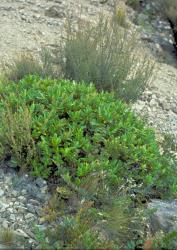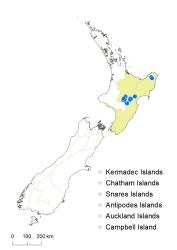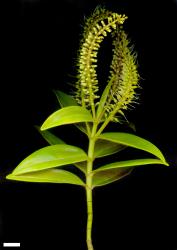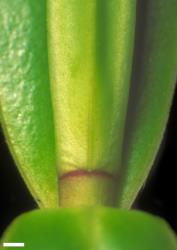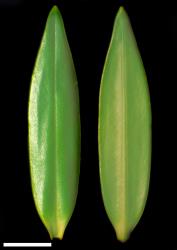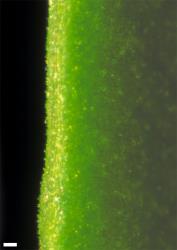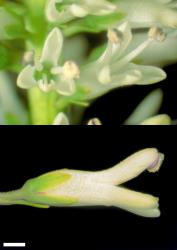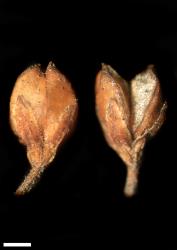- ≡ Hebe stricta var. lata L.B.Moore in Allan, Fl. New Zealand 1, 907 (1961)
Stems brown to dark brown when dry, glabrous or sometimes a few very short hairs in bifarious bands. Leaves lanceolate, narrowly elliptic, or oblanceolate, 26.0–70.5 mm long, 5.7–16.0 mm wide; lamina sub-coriaceous to coriaceous, eglandular-puberulent on midrib above, glabrous on midrib beneath; margin usually puberulent or rarely glabrous. Calyx lobes glabrous on faces, mixed glandular- and eglandular-ciliolate on margins; corolla tube > lobes.
Veronica stricta var. lata plants are characteristically low-growing and compact, spreading shrubs with usually glabrous or sometimes sparsely bifariously puberulent stems and firm, sub-coriaceous to coriaceous leaves. V. stricta var. egmontiana plants are distinguished by their narrower leaves, which are glabrous along the margins, although they may have short hairs just in from the margins.
Coastal forms of V. stricta (sometimes treated as var. macroura or under a broad concept of var. stricta) can have rather thick leaves of similar size and shape to leaves of var. lata, but these plants are diploid (2n = 40). They usually have hairs on the outer faces of the calyx lobes and shorter corolla tubes (1.5–3.5 mm long).
North Island: Gisborne, Volcanic Plateau, southern North Island (Raukūmara Range, Kaimanawa Mountains, Huiarau Range, Maungaharuru Range, and Kaweka Range).
Tussock grassland, low shrub, and open rocky sites above tree line. Recorded elevations range from 457 to 1525 m.
Flowers: January–March; fruits: March, persisting all year?
2n = 80 (see Bayly & Kellow 2006, as Hebe stricta var. lata).
The name koromiko is probably also applied to this variety, but no specific names have been recorded.



